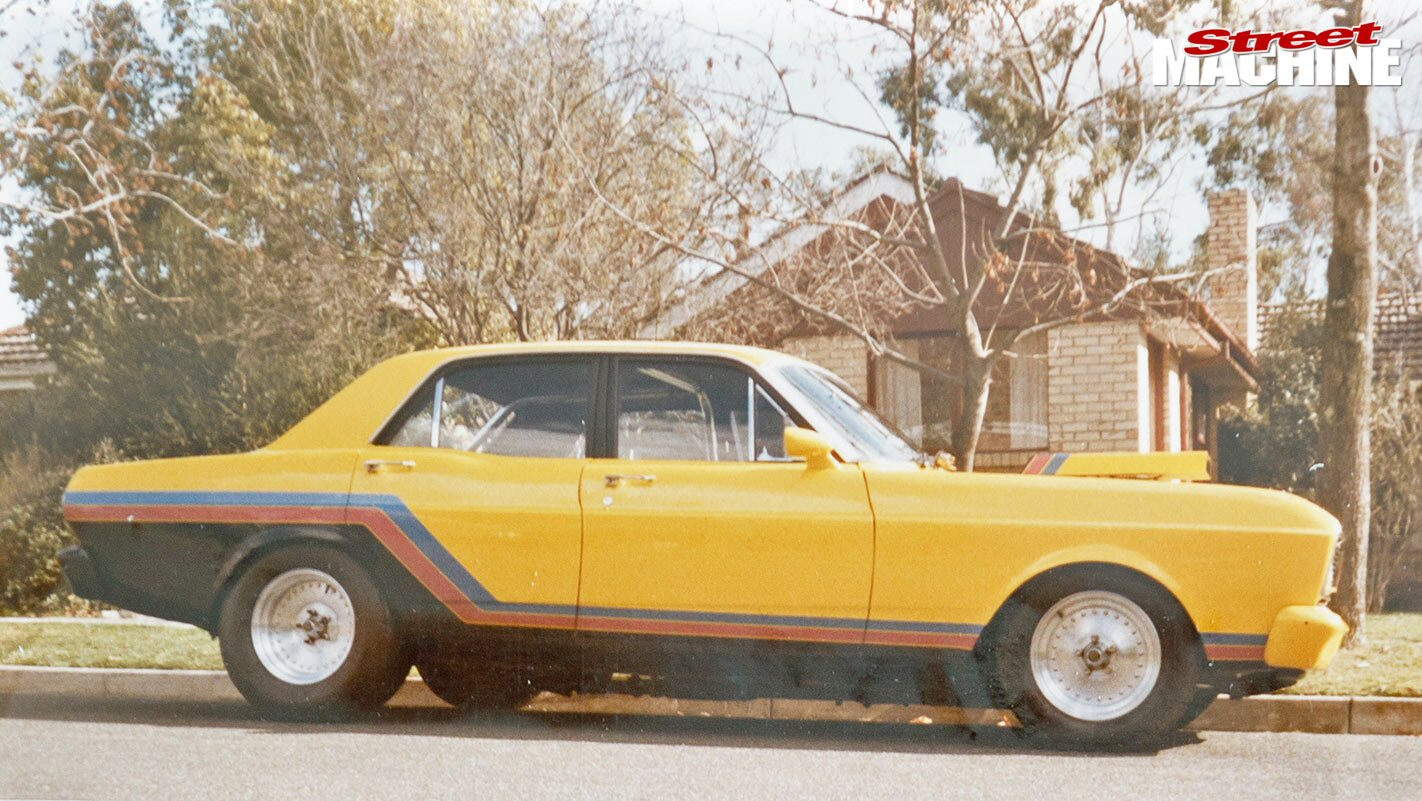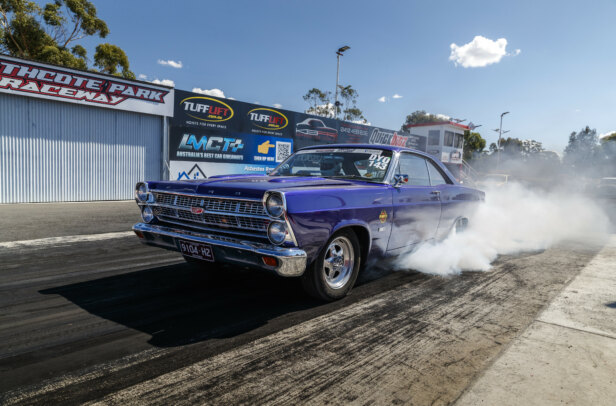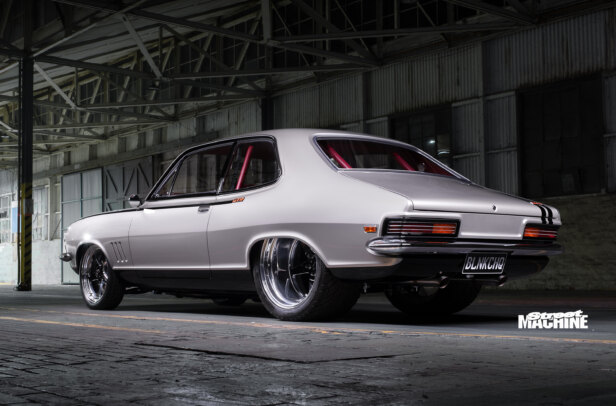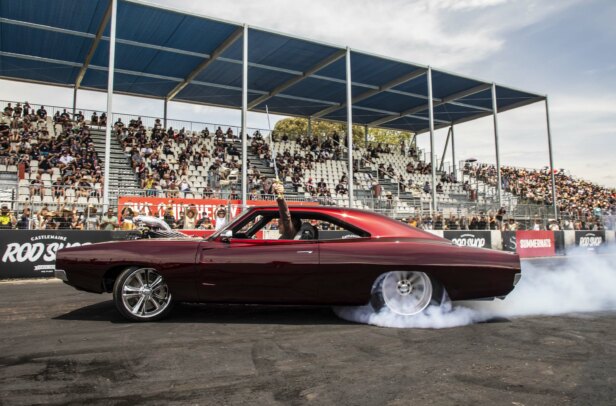AUSTRALIA’s aftermarket performance industry has always punched above its weight and shown the world just what our little island continent is capable of. One thing that many of our local aftermarket pioneers share is that their careers grew out of their hobby; names like Bennett, Hadfield, Splatt and Cowin all honed their craft by tinkering in home sheds.
This article was first published in the February 2020 issue of Street Machine
A similar grounding has seen Andrew Holdsworth forge a 40-year career as the man behind ET Performance Products, High Energy Oil Pans and Kool Wrap. We chatted to Andrew about cutting his hot-car teeth with an iconic XR Falcon sedan, and how he turned a ‘temporary’ post-uni job at a speed shop into a full-blown career.
Andrew in his office with one of the turbo blankets he markets under his Kool Wrap banner. “With the use of turbos booming in the modified car scene in recent years, we are constantly looking at ways to improve our current range and design new products as demands evolve,” he says
What sparked your interest in cars?
I was your typical eight-year-old kid, racing Matchbox cars around the polished wooden floors of our house in England; I’m sure that is where my interest in cars started. We immigrated to Australia in 1967 when I was 11, and when we visited Australia House for an interview, I was eventually asked if I had any questions. I said: “How old do you have to be to get your licence?” In my early teens I used to make plastic model hot rods, including Ed Roth-type customs, which also sparked an interest in drawing cars.
It was 1977, and Andrew talked the seller down to $1800 to become the proud owner of an XR Falcon sedan. GT-spec running gear and suspension were great starting points, but it wasn’t long before the modifications began in earnest. Working at the Graham Withers Speed Shop certainly came in handy in that regard!
The cars here must have been a lot different to what you were used to in the UK.
Most definitely. I remember my dad taking me to Sandown on my birthday in 1970, and I saw two red Falcon GTs driven by Moffat and Gibson demolish the opposition. From then on, I was a Ford guy. I would go to motor shows and collect the Falcon GT colour brochures to cut and stick on my bedroom walls. About that time I became interested in drag racing and subscribed to some great Australian drag racing and hot rod magazines. The Hardie-Ferodo 500 at Bathurst also captured my imagination. I remember a reporter asking Murray Carter why his Falcon was much lower at the front than the other Falcons; Murray just shrugged his shoulders and said: “The springs must have sagged!” Channel Seven was broadcasting Calder Park drags in the early-to-mid 70s too, although seeing any motorsport on TV was a rarity in those days.
“I had a great time reading about hot rods and street machines back when I was a young bloke,” Andrew says. “We had Supercar magazine, Street & Custom, Street & Strip and of course Street Machine. We all wanted to see our cars one day among the pages. Still, I would have known nothing about the pro street look without the American hot rod magazines”
Was there any particular car that inspired you as a young bloke?
I would have to say the XW and XY GTHOs. What tough cars they were in their day! I still have all of the newspaper clippings from the late 60s and early 70s that featured stories about the new Falcon GTs. I have a copy of the story that effectively killed the Phase IV and Holden’s V8 LJ Torana, when journalist Evan Green let his son drive a Phase III and wrote that it was crazy that an 18-year-old could buy a 140mph ‘supercar’. As far as modified cars go, I hitchhiked to Springvale one year and saw an amazing hot rod show; Joe Pirotta and Charlie Caruana had their ‘Crimson Pirate’ Model A bucket there on show, and it totally blew me away.
With the XR’s mechanical upgrades sorted, Andrew embarked on an exterior makeover in keeping with the US trends of the time. A bright-yellow base was then treated to candy graphics, bookended by colour-coded bumpers. How’s the newspaper mask job and house garage ‘spray booth’!
I clearly remember your yellow XR Falcon with the tunnel-rammed Windsor and graphics from the early 1980s. How and when did you buy it?
I did my HSC and went on to study industrial design at RMIT. I wanted to be a car designer and work at Ford, but student life meant that cash was pretty short in those days – my first three cars all cost less than $100! In 1977 I finally borrowed $1800 from Avco Finance to buy the XR Falcon with supposed GT running gear including a 351 Windsor. I finished at RMIT but couldn’t break into car design with the major car companies, so I took a temporary job at Graham Withers Speed Shop, and that changed my life. I ended up working there full-time for three years, and spent most of my pay packets on parts [laughs].
To me, your XR always epitomised the US pro street style with its graphics and Center Lines. The Pontiac GTOs of Dave Ryan and David Dann shared that look very early on, but surely your Falcon must have been the first Australian model built to that style?
It’s possible. The American Hot Rod magazine was the bible in those days and I watched closely as the pro street scene developed in the States. I replaced the auto in the Falcon with a Top Loader and added chrome 12-slots and a Pro Stock scoop. I took it to the Street Machine Nationals at Narrandera around 1979, and Chic Henry was there with a guy who had a late-60s big block-powered Chevy Impala. He swapped his front wheels for Center Line front-runners and we thought that look was the coolest thing we had ever seen. Drag racing was really starting to get big and we idolised the Pro Stock cars both here and in the US. The trend changed from building cars with flared guards and eight-inch tyres all ’round to making them look like drag cars. Pro Stock scoops were all the rage; then came Center Lines.
The first round of changes involved a respray in Midnight Blue, fat chrome 12-slots, drop pipes and a letterbox scoop. Tramp rods and a healthy dose of positive rake epitomise this early era of Australian street machining
Do you think early street machines like your XR are memorable because of the freedom back then to create something with its own identity, without worrying about whether people thought you were ‘wrecking a classic’?
We never had the foresight to think they would ever be classics; they were just everyday cars, like the last of the Falcons and Commodores are now. Most of us couldn’t afford a new Monaro or Falcon GT, so we had to build our own budget versions. You’d work two jobs just to earn enough money for a paintjob. One year my wife bought me a set of chrome-moly piston rings for my birthday. Remember, standard cars from the 1960s and 70s were never built to go down a race track; if you wanted to drag-race your street car, you had to change everything between the engine fan and the diff housing, because the standard parts wouldn’t hold up. Now you can put a chip in an SS Commodore and run 12s!
The final and most popular guise of Andrew’s Falcon saw it attend numerous local and interstate events before being sold off in 1986. Nearly 40 years later, the pioneering build style and iconic looks have made his XR one of our best known and most revered Australian street machines
I remember the feature in Street & Strip magazine that had you guys masking up the XR’s graphics with newspaper! Those times must hold some pretty special memories.
Most definitely. A friend painted the Falcon Midnight Blue in 1978, and then in 1980 my brother-in-law Paul and I pulled it apart and did a heap of work to it in the garage. We went to change the camshaft then, but as often happens when you start to pull an engine apart, we found that everything needing replacing. The pistons had cracked skirts, which triggered a full rebuild. It was hard to find performance parts for 351-cube Windsors back in those days. I couldn’t buy forged pistons for it, so I used 327 Chev flat-tops and decked the block .090in to get the right deck height. We pulled the car apart again the following year and painted it the yellow with candy red and blue stripes. I used a colour scheme I’d seen on a US Chevy Nova, with some changes. Painting the bumpers was a fairly new idea back then, and we fitted aluminium panels to the engine bay mounted with Dzus fasteners. Working in your own garage without the prospect of professional help meant you had to be a little ingenious. We had to hand-make parts rather than go and buy them.
We featured the Falcon back in our Sep ’87 issue after you sold it to the Vucinic brothers. Was it a hard decision to part with it?
It was heartbreaking to sell, but we needed money to start our own business. The two brothers that bought it were really young – like 16 and 19 – and it was their first car. They couldn’t quite raise enough money to buy it, so I was able to reduce the price by putting cheaper wheels on it. They planned on driving it regularly, so I was happy to take the Center Lines off anyway; they would have killed themselves trying to drive it fast with the front-runners. I’ve got no idea how they handled the Mr Gasket vertical-gate shifter, either.
Andrew and his brother-in-law Paul rebuilding the XR. They screwed together a tough Windsor for it using what they’d learned in books and magazines. “The 351 Windsor was a difficult engine to build, mainly due to a lack of aftermarket parts at that time,” Andrew says. “It ended up with modified Chev forged pistons, L34 valves and a 289-302 tunnel ram adapted to fit using custom spacers at the heads”
So with the money from the sale, you started ET Performance Products?
I thought about opening my own speed shop, but decided that there was more growth potential in going the wholesale route, so ET Performance Products began in 1986. It was a funny cause-and-effect actually, as the XR and the whole passion for street machines triggered the business idea after I imported an ET performance timer for the Falcon back in 1985, a dash-mounted quarter-mile timer that received distance measurements off a transducer mounted next to the tailshaft. That one purchase led to going full-time wholesaling performance parts in 1986. We then bought High Energy Oil Pans in 1988 and both businesses grew substantially over a 20-year period, eventually employing 15 staff and becoming an official supplier to Repco, Burson, Supercheap and Autobarn. High Energy grew to become the largest manufacturer of modified oil pans in Australia, and we worked with some great engine builders and race crews, including V8 Supercars teams. I sold up in 2008 and now run a consulting business, as well as a company called Kool Wrap, supplying specialist heat-protection products to the performance car industry, as well as marine, industrial and agricultural customers.
This super-cool Certificate of Performance from Calder Park is a memento of Andrew’s first forays into drag racing; a [email protected] was nothing to sneeze at for a street car in 1979
What sort of cars have interested you since you sold the XR?
In the early 1990s I bought my dream car: a 1967 GTA big-block Fairlane. It was pretty rough and missing the motor and gearbox, but I gradually built the car over the next 15 years in between having a family and building the business. One of the guys at High Energy did a ton of work to it, including chopping off the US front subframe and grafting on an Aussie Fairlane front, as well as narrowing the rear end, adding subframe connectors and countless other jobs. We built a 500hp 460 engine backed by a Turbo 400, fitted nitrous, and had it painted by famed Melbourne body man Trevor Davis. Sadly I couldn’t find the last 400 hours needed to assemble the car and sold it in 2007. I’ve also owned some other great cars, including a 1995 GT-R Nissan Skyline. What an amazing car! We changed turbos, fitted the latest APEXi ECU, and, being an agent for Turbosmart, added their e-Boost controller. It made an easy 450hp, and we successfully raced the car in road events and rallies. That’s another car I shouldn’t have sold. I also had a G6E Turbo Falcon and fell in love with the turbo Barra motor; I can’t believe what the latest generation of street machiners have done with modded Barras. I may have to fit one to an old Falcon at some stage. These days I have a Porsche Boxster S, which is the perfect street car and track-day racer, but I still want to get another GTA Fairlane one day – I have unfinished business there!
The carb scoop is the last remaining piece Andrew has of the XR, after selling it with normal air cleaners atop the tunnel ram. “I drove the car from Melbourne to Canberra for the Street Machine Nationals one year and left the bonnet in the shed; I just had the yellow scoop sitting on top of the carbs the whole time,” he says. “After driving it 1400km like that, I was nearly back home when I got stopped by the cops and given a canary about 800m from my driveway!”




Comments